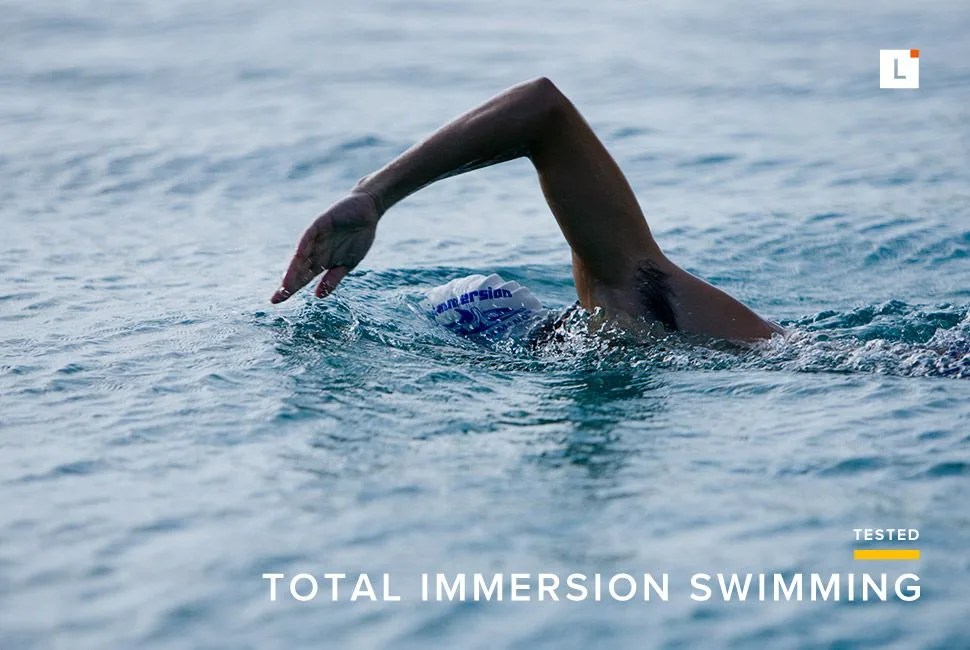It made me angry that the obese woman could swim faster than me. In my bubble of intense training for my first triathlon, I’d fashioned an idea of justice that allowed fit people to naturally be better than other people at everything. I raked and windmilled my arms through the water in the windowless, basement-level pool at the local YMCA. 5:30 a.m. to avoid the crowds. By 5:45 a.m. I’d be winded, exhausted. Have a Gu. Adjust my goggles. Stretch the lats out. Out at 6:00 a.m., even more angry. There had to be a better way to learn how to swim.
MORE SWIMMING: Most Challenging Open Water Swims | Road to Ironman | Escaping from Alcatraz
It’s a fact that learning to swim well requires a blue collar work ethic, and what Total Immersion Swimming ($35) presents is not a quick fix or shortcut. Rather coach Terry Laughlin’s approach to swim instruction prioritizes minimizing drag first, teaching students to become “slippery” in the water rather than trying to push and pull it around. It has a yogic quality to it, beginning with the first lesson, “Relax into ‘Weightlessness’”. The first drill of this lesson is the “Superman Glide” in which the swimmer pushes off the pool wall, arms forward, and glides without kicking. “Your primary focus is to streamline and sink into weightlessness”, the omniscient Laughlin says, while the shirtless and goggled Laughlin demonstrates. “Repeat back and forth in shallow water, feeling weightless, effortless travel”. Whoa. I totally feel it.
Joking aside, the revelation that roughly three of such pushes (using the floor to push in a shallow pool) can move a swimmer from one end to the other in a 20-meter pool is small but profound — not bad for lesson 1.1. And this is how the lessons proceed: one incremental revelation building on the next, from “Lesson 2: A More Slippery You” on up through “Lesson 10: Tune Your 2-Beat Kick”. You might call these revelations tricks, in a way, like learning to “skate” in lesson two; you’re simply gliding with body rotated and one arm extended, but this insight is a clever breaking down and rephrasing of a fundamental motion in the swim stroke. In an article for CrossFit Journal, Laughlin refers to his style of swimming as kaizen, a Japanese word that he says “denotes incremental improvement through cleverness, patience and diligence”. TI is clever, like “The 4-Hour Workweek” of swim instruction: you won’t actually work four hours, but the tips and tricks reap short-term gains that make the work rewarding as you build toward the ultimate goal, whether that’s being in control of your work life or being a complete swimmer.
It’s worth noting a minor debate that took place on a notoriously esoteric triathlon website and forum, Slowtwitch, in which Olympic gold medal swimmer Sheila Taormina took Laughlin to task for not adequately teaching propulsion. TI is good for people trying to get through a swim, she said, but not for those who want to be fast, competitive swimmers. “I compare it to an engineer who designs a car that is so sleek and aerodynamic but who neglects to focus on the drive-train”, she said. Laughlin countered that he prioritizes drag reduction because the goal of most swimmers, especially adult novices and age-groupers in triathlon, is to swim at a relaxed, controlled, sustainable pace. “Swimming fast”, he said, “should be viewed as the sports-skill equivalent of a black belt in karate”.
I like Laughlin’s Zen master approach, and I wish I’d heard about it sooner. I was fortunate to relearn swimming from a friend who swam at an elite level when I was preparing for Ironman in 2012. Nothing beats hands-on, one-on-one instruction, but that just isn’t an option for most adults because of time or resources. Let’s face it: if you’re trying to learn to swim from a $35 DVD or a two-day workshop (TI offers workshops as well) then you’ve probably got some skill honing to do before you’re gunning it in the fast lane. And as Laughlin says in his article about kaizen swimming, it’s a life-long process with endless room for improvement. I now use TI to for exactly that reason; I just started working on butterfly with Laughlin’s “BetterFly for Every Body” program.
The final thing to note is that many of the foundational drills aren’t consistent with crowded gym pools; they require a bit of space to practice without interference, either at a pool with free swim hours or in the slow lap lane during off hours. For novices, especially those who are fit and skilled in other sports, this can be a humbling experience. You will be passed by people who are older, fatter, not as good looking. But remember, the pool is like an alternate universe with a different set of laws — big muscles sink, children in orange shorts are the authority figures, everyone has latex hats. Your goal is simply to streamline and sink into weightlessness. Let the rest go.
